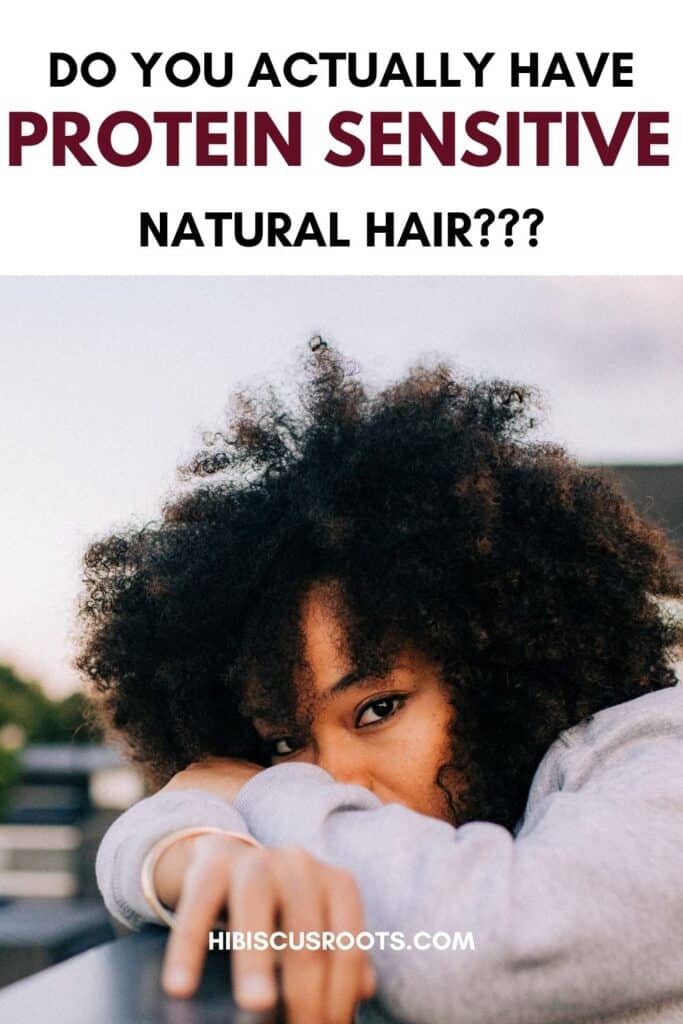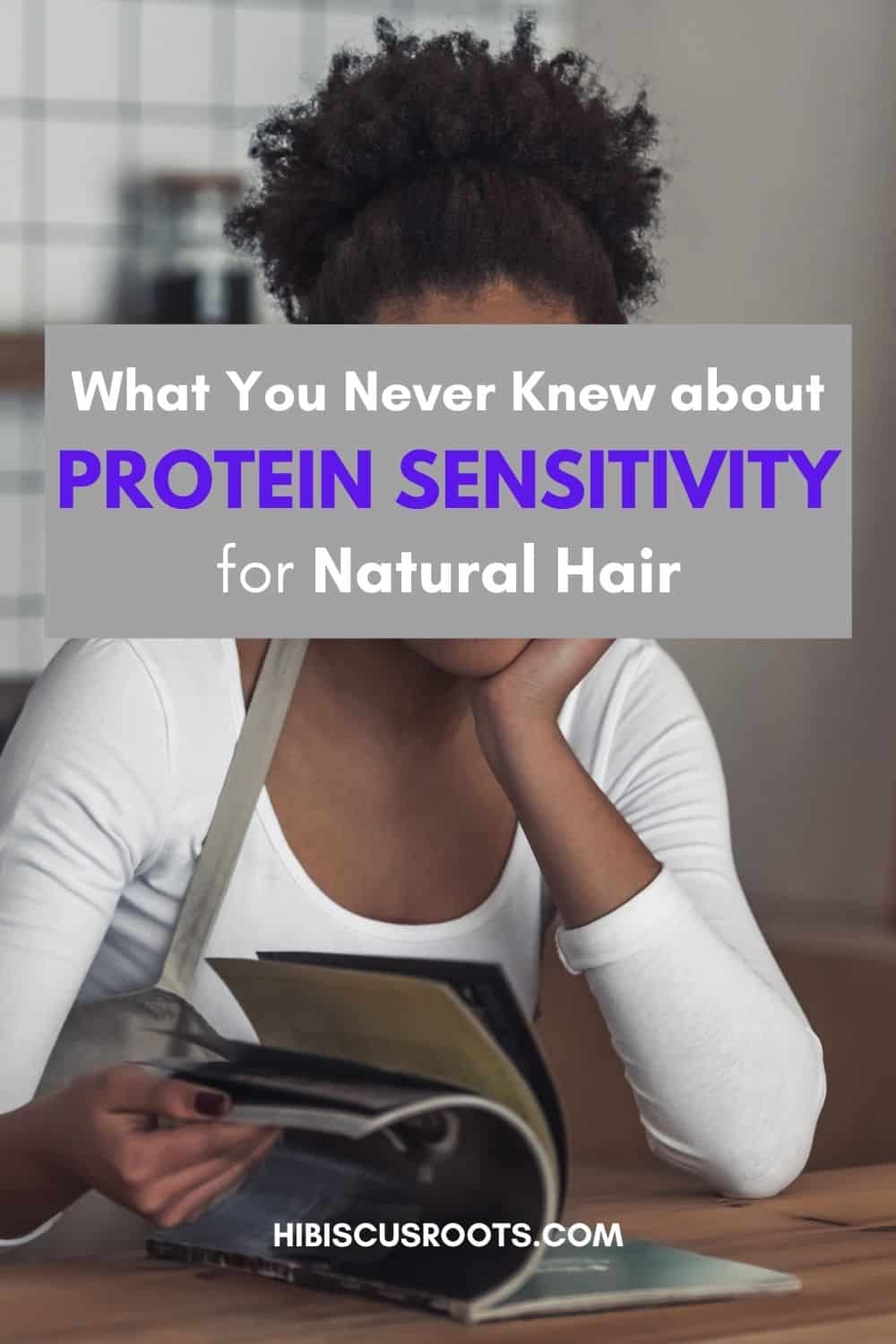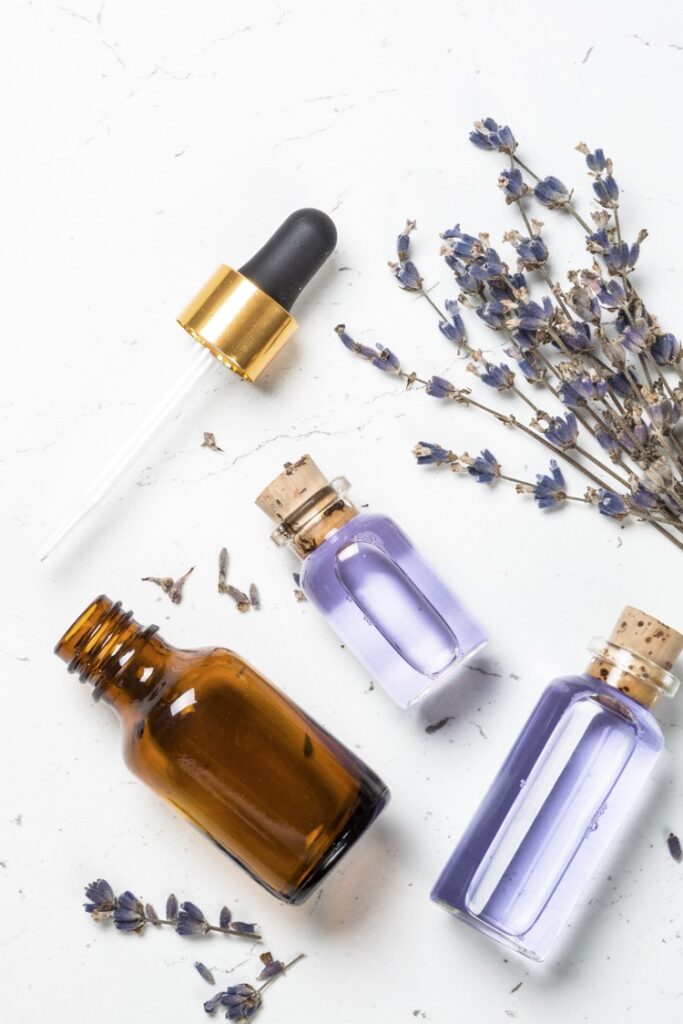Updated: March 28, 2021

In this article, we’re going to be breaking down what exactly protein sensitive hair is, how to tell if your hair is protein sensitive, the different kinds of proteins for natural hair care, and how to strengthen your natural hair if you absolutely cannot use protein!
If you have low porosity hair or extremely fine and dry hair, avoiding protein is probably something you’ve been advised to do.
However, this might not necessarily be a default rule. Having sensitivity to one protein doesn’t mean you’ll be sensitive to all of them.
What is Protein Sensitive Hair?
Protein-sensitive hair is hair that reacts negatively to protein. The reaction can also differ depending on the type or size of the protein you try.
By “reacting negatively”, we mean that your hair can become excessively dry, hard, brittle, or shed excessively. And this can happen for a number of reasons.
1. You may have an allergy to certain proteins
You may not have considered the ability of protein to cause an allergic reaction for you but this very possible.
If you have an allergy to certain protein molecules, the skin on your scalp can become inflamed or irritated when you use products that contain them.
2. Your hair protein content is already naturally high
Hair is made up of proteins. And as we’ve explained in this post, the way to achieve healthy hair is by keeping this protein in balance with moisture.
However, if your hair naturally has a good protein content, adding protein products and protein treatments into your regimen will EASILY tip the scale. Your hair may react to this by becoming hard, dry, and brittle.
How to Tell if Your Hair is Protein Sensitive!
Here are some easy ways to tell if your hair is protein sensitive:
- Your hair becomes dry, brittle, or hard after a protein treatment.
- Your hair does not react negatively to skipping protein treatments, and you rarely experience moisture overload or hygral fatigue.
- Products that contain protein don’t work for your hair, or they might even damage your hair.
It’s important to note that the only way to tell if your hair is protein sensitive is by mindful observation. It’s one of those things that may not be obvious if you aren’t tracking information about it or paying attention.
Start writing down everything to do to your hair in your Hair Journal. If you notice your hair reacting negatively to a product, write down its ingredients. Then, remove products that contain protein from your natural hair routine and see if your hair condition improves.
Is Low Porosity Hair automatically Protein Sensitive?
Low porosity hair has a cuticle that is only slightly open, and more difficult to penetrate.
The reason people often say that low porosity hair protein sensitive is that some of the “film-forming” proteins we talked about above make it even more difficult to get nutrients into low-po hair strands.
So if your hair cuticle is already relatively closed, and difficult to penetrate with moisture a product that forms a protective coat over the strand may not help matters.
These film-forming proteins are great for ladies with high porosity hair who struggle to close their hair cuticle once they’ve nourished their hair.
Fortunately, not all proteins are equal: they don’t all coat [read: choke] the hair strand. Some are softening, smoothing, and help increase elasticity.
While others, like wheat protein, actually easily penetrate the hair strand and are absorbed all the way into the cortex. This type of protein would be perfect for low porosity hair.
How to Care for Protein Sensitive Hair
So if you try out all of the different kinds of protein and they don’t work for your hair. OR you realize right away that you have an allergy to protein, all hope is still not lost.
1. Use protein alternatives
There are still products like henna that are protein-free but behave like protein treatments. This may help to strengthen your hair strands depending on your particular protein sensitivity. You can read our detailed article about henna and all the great benefits it has for natural hair here!
2. Increase time between protein treatments
Instead of doing a protein treatment once a month, or every other week like some natural hair “rules” would state. Try extending the time between your protein treatments. Some naturals can only do a protein treatment once a year without seeing adverse reactions!
What are the Different Kinds of Protein for Hair?
There are a few different kinds of protein molecules that can be important for a healthy hair regimen. You should have a good balance of these because some of them serve very different purposes.
What’s also great is that if you realize you have a sensitivity to one of these proteins, you can always try another!
1. Silk protein
This kind of protein serves to strengthen and soften natural hair. It is also called silk peptide and is gotten from the center of the silkworm yarn. Silk protein forms a protective film over the surface of the hair, improving its natural shine. It usually appears on ingredient labels as “Hydrolyzed Silk Protein”.
2. Collagen protein
This protein increases hair elasticity, thus reducing the chances of breakage. This is because it is a strong material that binds cells together and supports most tissues.
3. Vegetable protein (like soy)
This protein is hydrophilic (aka humectant). This means that it attracts water into the hair shaft. In addition, this kind of protein can easily penetrate any hair cuticle! So it’s a godsend for most low porosity naturals! It usually appears on ingredient labels as “Hydrolyzed Soy Protein”.
4. Keratin protein
This kind of protein strengthens and restructures the outer layer of the hair cuticle. It also works to make the hair strand smooth and silky. It usually appears on ingredient labels as “Keratin” or “Hydrolyzed Keratin”.
5. Wheat protein
This is another kind of protein that forms a film over the surface of the hair strand. In doing this, it softens the hair, moisturizes it, and prevents it from drying out. It is one of the few proteins that can penetrate the cortex (or the middle layer of the hair strand). It usually appears on ingredient labels as “Hydrolyzed Wheat Protein”.
You can read more about the general benefits of protein for your natural hair in this post. You can then read more about how to analyze product ingredient labels in this post.
Conclusion
The point we always try to make here at Hibiscus Roots is that there is no general rule of thumb. There are no hard-set rules when it comes to natural hair care.
I know it can be overwhelming to hear this. Especially if you have no clue where to begin.
“What do you mean I can do anything to my hair??”
I know.
But this is meant to be reassuring.
The best way to figure out how your hair reacts to something is to try it.
You can read about how low porosity hair reacts to it, how 4C hair reacts to it, how fine hair reacts to it as much as you want.
And though these all may give you a CLUE as to how your own hair might react — you won’t actually know until you try.
featured image: source



